How To Know If A Pan Will Fit In Your Toaster Oven
Does this sound familiar? You find a great pan that’s supposedly designed for “standard-size” toaster ovens. You buy it, bring it home, and womp womp the pan doesn’t fit – it’s too big.
The secret to avoiding this frustrating experience is simple: measure the inside of your toaster oven before you shop. All you need is a few minutes, a tape measure, and this handy guide!
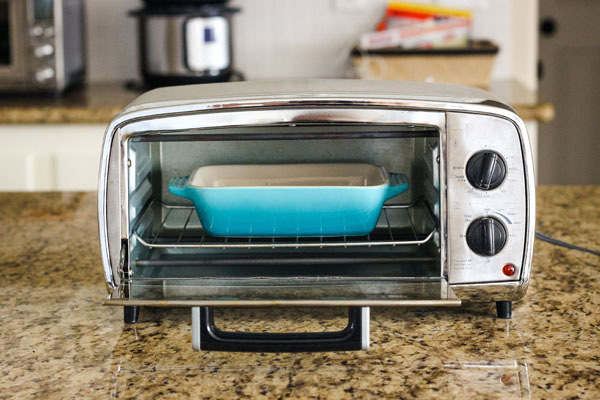
Ready To Measure The Interior of Your Toaster Oven?
Similar to cleaning a toaster oven, always make sure your oven has cooled completely and is unplugged before you start sticking your hands in it.
Step 1: Measure The Length
Most toaster ovens have rack guides on the sides of the ovens that extend beyond the wall. Manufacturers don’t usually take these guides into account when listing the interior cooking space.
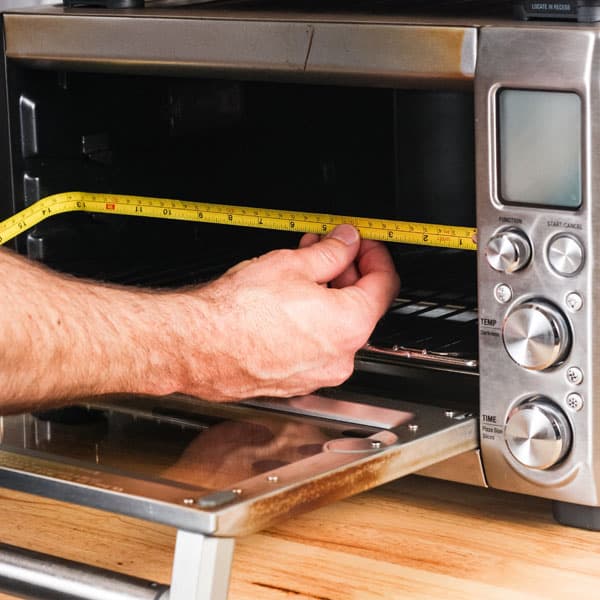
In our main oven, a Breville Smart Oven Pro (BOV845BSS), the guides pop out about ¼-inch on each side.
For the most accurate length measurement, place your tape measure against the guides/popouts and not just the walls of the toaster oven.
Step 2: Measure The Height
Next place the cooking rack in the lowest position. Then, measure the distance between the cooking rack and the upper heating elements.
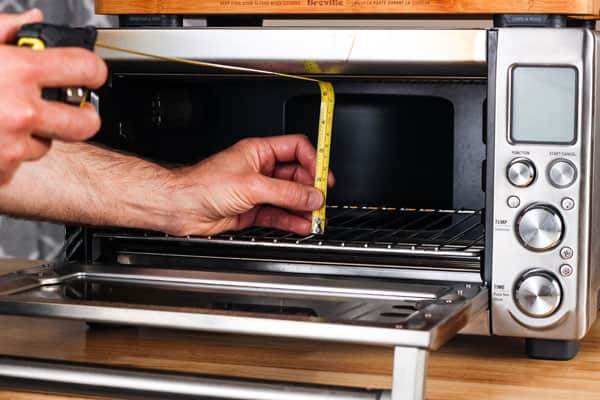
Quick Tip: Try to avoid actually touching the heating elements with the measuring tape. Some ovens use quartz heating elements which are more delicate and easily damaged.
In our main oven, there is a third upper heating element that is used when broiling. It’s in the middle and sits a little lower than the other two elements.
If your oven is similar, you’ll want to measure from the cooking rack to that lowest-sitting top element.
Step 3: Measure The Depth
Lastly, measure from the front of the cooking rack to the rear of the toaster oven.
Some toaster ovens have a curved pop-out in the back of the oven to accommodate cooking a large pizza.

This curved area does not usually go the length of the entire back wall of the oven.
If that is the case with your toaster oven, measure the shortest distance to the back wall and ignore the pop-out.
Okay, I’ve Got The Measurements, Now What?
When I was first searching for pans for our little oven I would keep these measurements in a note on my phone. That way I could easily refer to them when shopping.
The Proper Fit
Just like in a traditional oven, pans and baking dishes should never touch the walls or the door of a toaster oven.
That’s because there needs to be enough space for the oven’s hot air to circulate freely. Using oversized pans and obstructing the oven’s airflow can lead to uneven cooking and other undesirable things (like a potential fire hazard).
For sheet pans, I like to have as much space as possible but at least ½-inch between the oven walls and each side of the pan.
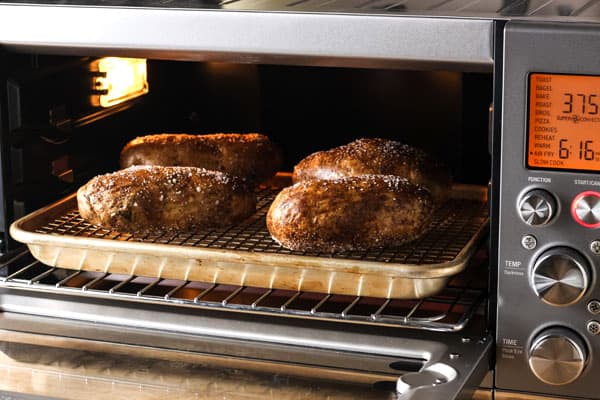
When using covered baking dishes, I try to have at least 1½ to 2 inches of space from the top elements.
The exact amount of space needed is going to depend on your oven. Because there are so many styles of toaster ovens, please read your owner’s manual for specific directions.
In addition to following your manual, you should always double-check the Care and Use Guidelines for any pan or baking dish before cooking with it in a toaster oven.
Learn More >>> 4 surprising Things I’ll Never Use In Our Toaster Oven
Baking Pan Sizes
Now that you’ve got your oven measurements and you’ve read your manual let’s focus on the other side of this pan problem…how to know the size of your baking pan.
When people talk about a pan’s size (like an 8 x 8-inch pan or a 13 x 9-inch pan) they are usually referring to the interior dimensions (measured from one inside edge to the other).

The interior dimensions do not include any exterior handles or the pan’s thickness.
Take our favorite 7 x 5 baking dish. As you can see the exterior dimensions are very different from the interior ones.
This isn’t a bad thing. It’s just something you need to be aware of when shopping online and especially if you’re cooking with a smaller oven.
The good news is that some manufacturers (like Fat Dadio, Nordic Ware, and Lodge) have started including measurements for both the interior and exterior dimensions of the pans sold on their websites.
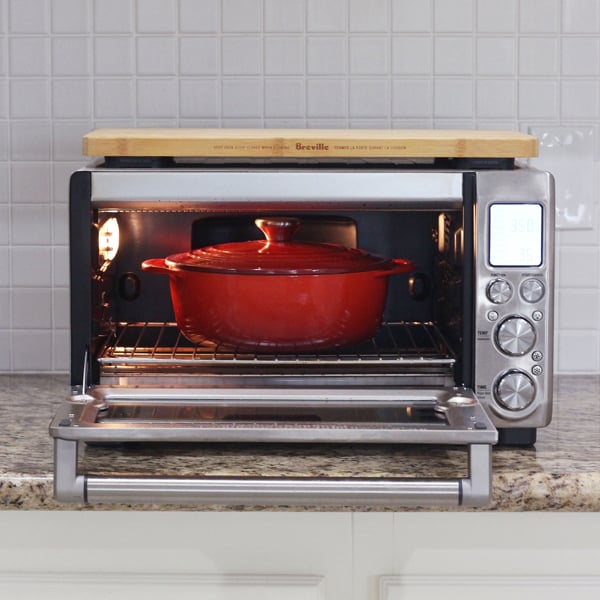
Lastly, be cautious of covered baking dishes (especially when purchasing online). Often the height listed in the description is only for the dish itself, not with the lid on it.
If you’re unsure about the measurements supplied for a pan or baking dish, just email the company and ask.
It might take a day or two to hear back but if you get to avoid the hassle of a return, I’d say it’s worth the wait.

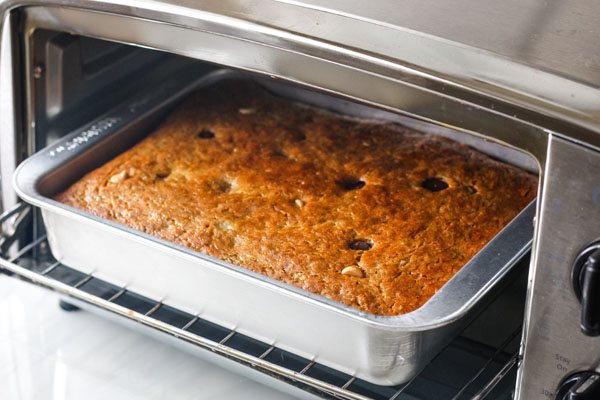
just purchased an Oster toaster oven. Put biscuits in the oven and set temp according to instructions on package. the biscuits browned very quickly but the center was not done.
Hi Johannes,
It could be a few different things that caused your biscuits to turn out that way. Here are some ideas/suggestions.
1. Rack Placement: most recipes direct to bake biscuits on the center rack. If your oven has 3 rack placements and you used the center one, try moving the rack to the bottom placement next time. That should slow the top browning and increase the heat to the pan/biscuits to cook the center through.
2. Temperature: Some ovens run warmer than the temperature dial says. Using an oven thermometer can help to see if there is a difference between the display temperature and the actual oven temperature. We have a post that might help: https://toasterovenlove.com/toaster-oven-temperature-and-heating-tests/
3. Convection: If your toaster oven is a convection toaster oven or if you are using the convection/turbo setting on your oven, you will want to reduce the temperature (about 25 degrees) when baking.
A convection fan continuously circulates heated air around the oven which can lead to baked goods browning too quickly outside before they can cook through the center. This post has lots of info about cooking with convection: https://toasterovenlove.com/7-things-you-should-know-about-convection-toaster-ovens/
If you’re just trying to get your biscuits baked and want to save the reading for later 🙂 I’d start with turning the oven temperature down 25 degrees and see how things go.
Hope that helps and happy baking with your new oven!
~ Brie
Hi, Brie,
Thank you for sharing the experience of knob/handle removing/replacing, it is very helpful. Prime Day is coming within two weeks, hope to find deals on Breville.
Hi, Brie,
What’s the height of your Le Creuset shallow 2.75 Q with lid on? Can a 5″ height cast oven fit in BOV845BSS? I’m doing some homework for a new toaster oven, can’t decide which Breville to get since I hope for the one with the smallest footprint possible. Zojirushi is on my list too if only I can figure out the real interior cooking surface.
Hi Karey,
We’re more about the cooking after you buy and don’t sell/recommend any particular oven so I’m not super good with those kinds of specifics.
But Williams Sonoma has a good sales page for the Breville BOV845BSS with lots of info about the machine. You can see it here: https://www.williams-sonoma.com/products/breville-smart-oven-pro-with-light/
They show the dimensions for the interior are 13 1/4″ x 11 1/4″ x 5″ high. Which are the same as our Smart Oven Pro BOV845BSS.
With Dutch ovens, in my experience, it’s less about the lid and more about the knob/handle. The knobs are usually around an inch or so tall.
We have two Dutch ovens that we use in our Smart Oven Pro and both of them have a very small amount of space between the knob and that lower center heating element.
The Le Creuset Shallow 2.75 Quart with the lid is only around 4 inches tall but with the knob, it’s almost 5 inches tall.
Also, that Dutch oven came with a composite knob that was only oven-safe up to 390F. So we had to buy one of their stainless steel knobs that are oven-safe up to 500F to bake bread with it. And because the knob was going to be so close to that one heating element I was worried the lower temp knob might melt.
The other Dutch oven we use is a 2 Quart Martha Stewart (you can see it on this no-knead bread recipe: https://toasterovenlove.com/small-no-knead-bread/. The pot and the lid together are also only around 4 inches tall. That pot came with a handle that was a little too tall so I replaced it with a small stainless steel knob – with the new knob, it’s just a tiny bit less than 5 inches tall.
There are a lot of Dutch ovens, these are just the ones we use. I know that some of our readers can fit even larger pots in their toaster ovens/countertop ovens, they just remove the knob if it’s too tall and leave the hole open or plug it with foil. The key to that is making sure the knob can be removed – some of them are welded onto the pot lid.
Apologies for the book report 🙂 but I hope it was helpful. Good luck with your search!
~ Brie